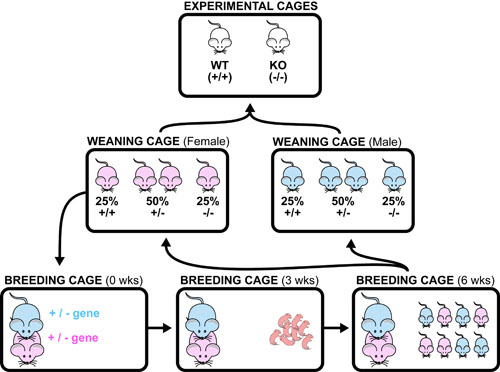Careful breeding/husbandry of mice is important when one is asking genetic questions about disease. Such questions include: “Does gene X contribute to cancer?”, “Does my drug treat cancer by targeting gene X?”.
In general, these questions can only be answered by comparing mice that have gene X (WT or +/+) or don’t have gene X (KO or -/-). To make sure the genetic difference is the only difference between the mice, you usually compare siblings of inbred mouse-lines which have the same sex, age, environment and genetic background.
All mice have two copies of every gene: one from their father and one from their mother. If a mouse has two working copies of gene X this is signified by “+/+” and this mouse is called a wild-type (WT) homozygote. If a mouse has no working copies of gene X this is signified by “-/-” and this mouse is a knock-out (KO) homozygote. Finally if, a mouse has only one working copy of gene X this is signified by “+/-” and this mouse is called a heterozygote.
- “Breeding cages” form the foundation of any animal breeding strategy (see figure above). To make sure you get both WT and KO siblings the parent mice must both be heterozygotes for the gene of interest (+/-). On average, it takes 3 weeks for mice to gestate and another 3 weeks for the newborn mice to be weaned from their mother’s milk.
- After 6 weeks you separate these mice by sex into what are known as “weaning cages.” Weaning cages serve two purposes: (1) they prevent uncontrolled breeding of mice and (2) they divide the mice by sex so that you can compare males to males and females to females in your final experiment.Once the mice are weaned you test them for the gene of interest using polymerase chain reaction (PCR). In general you should get 25% WT mice, 25% KO mice and 50% Htz mice (see figure above).
- The WT and KO mice you can use for your final “experimental cages” while the Htz mice can be used for starting new breeding cages (see figure above).

This work by Eugene Douglass and Chad Miller is licensed under a Creative Commons Attribution-NonCommercial-ShareAlike 3.0 Unported License.

